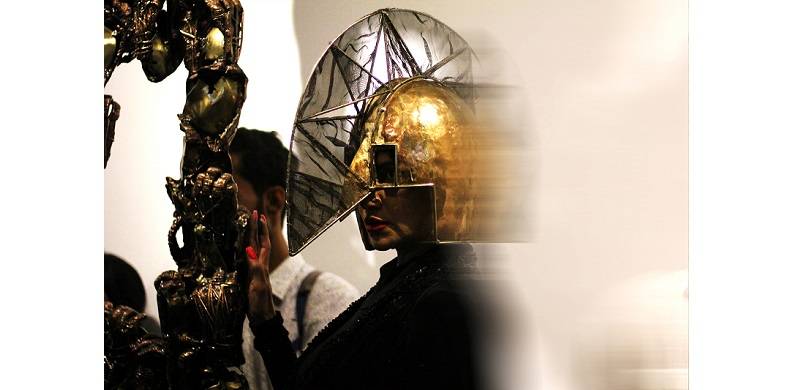
Layers of intimacies and navigations occur over the course of Fairytale 72, a collaborative performance presented by Amin Gulgee at the opening of his exhibition of sculpture, Spooky Action at a Distance, at Canvas Gallery in Karachi. Oscillations between senses, bodies and surfaces outline a portrait of an entanglement that traces a path back to the artist himself. The first layer, however, manifests as an inhabitation: 17 performers inhabiting the objects curated in the space; the audience inhabiting the gallery, changing its contours and surfaces, waiting often in clusters in anticipation of what’s to come. The space is activated through this intimacy, one that takes many forms. Usama Khattak carries Amin wrapped in white cloth through the crowded gallery to a front courtyard, where he douses him in colour. Umaina Khan and Safeer Jaffery move around and on top of Amin’s monumental sculpture The Iron Horn (2023), singing in Saraiki of a beloved calling them back. The lingering scent of spices heated in a skillet by Sara Vaqar Pagganwala beckons from beyond the entrance doors. The audience must make a choice of who to follow.
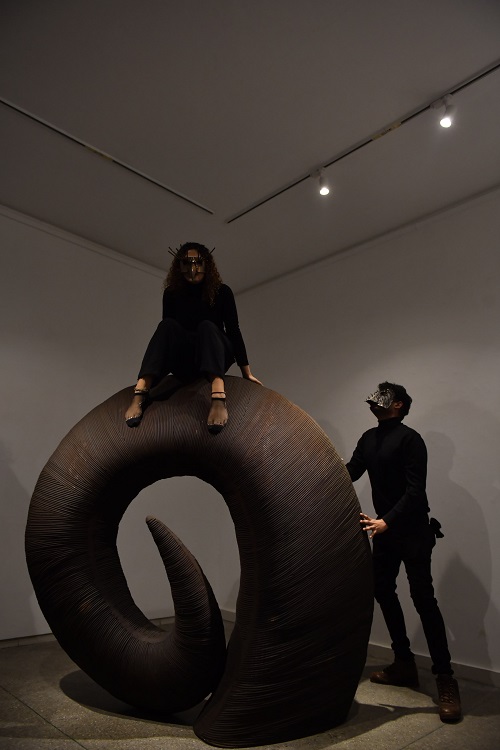 Materiality plays a dual role, as the sculptures themselves are constantly in an act of producing space, of curating expectations of what it is to follow. Each of the seven helmets taken off their stands and worn by a performer reads like an embodiment of a distinct spiritual facet. Through witnessing this process of becoming—the birth of these new roles that emerge as performer interacts with sculpture—the audience has an opportunity to become a part of the journey that Amin has imagined. Imbuing objects with changing meanings allows these inanimate participants to become collaborators as well, carrying a story through movement that perhaps they cannot express in stillness on a plinth or placed against a wall. Even the sculptures that remain in place, such as Perforated Scroll (2018) or Ascension (2018), stand almost as talismans, visual manifestations of a collective state unfolding in the present moment. There is a spirituality literally present in the materiality of Amin’s objects.
Materiality plays a dual role, as the sculptures themselves are constantly in an act of producing space, of curating expectations of what it is to follow. Each of the seven helmets taken off their stands and worn by a performer reads like an embodiment of a distinct spiritual facet. Through witnessing this process of becoming—the birth of these new roles that emerge as performer interacts with sculpture—the audience has an opportunity to become a part of the journey that Amin has imagined. Imbuing objects with changing meanings allows these inanimate participants to become collaborators as well, carrying a story through movement that perhaps they cannot express in stillness on a plinth or placed against a wall. Even the sculptures that remain in place, such as Perforated Scroll (2018) or Ascension (2018), stand almost as talismans, visual manifestations of a collective state unfolding in the present moment. There is a spirituality literally present in the materiality of Amin’s objects.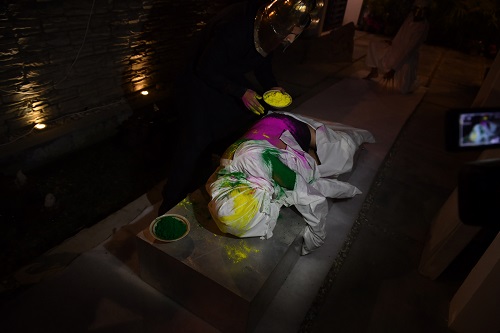
And there is an emotive quality central to the unraveling of the performance, fragments of which are dispersed amongst objects and people; a sense of grief and longing lingers in their movements. The ritual and repetition in these movements create a sense of familiarity that can almost be tasted amidst the sights, sounds, textures and scents. It is a feeling that persists even in absence, in moments when one can only access glimpses through a crowd, sensations traveling to you still. Perhaps it is this element of familiarity that lends the illusion of order, of a secret that the audience is being let into, a fleeting feeling that one might place the fragments together and it will all fit neatly into a narrative.
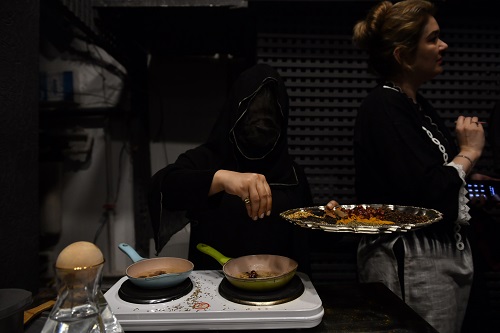 Performance art is meant to expose the body of the artist, the materials, surfaces, spaces within which the artist is working, and Amin does this beautifully by extending this exposure to the audience as well. This collaborative performance, like many others that he has conducted, utilises the somewhat confined space of the gallery. At first it feels suffocating to move through a sea of people hungry to be entranced, but this spatial limitation reveals itself to be an offering instead. It is an almost necessary aspect of the unfolding of the experience, forcing the audience to be immersed, and in some sense to emerge as something slightly different, changed through their interactions, their participation or acts of retreat, carrying that forth outside the space even once it’s over. People leave knowing they are witnesses and storytellers of the moments they experienced in physical closeness. Perhaps it’s not necessary to see every detail. Perhaps it is enough to ‘know’ only a specific aspect of the whole performance.
Performance art is meant to expose the body of the artist, the materials, surfaces, spaces within which the artist is working, and Amin does this beautifully by extending this exposure to the audience as well. This collaborative performance, like many others that he has conducted, utilises the somewhat confined space of the gallery. At first it feels suffocating to move through a sea of people hungry to be entranced, but this spatial limitation reveals itself to be an offering instead. It is an almost necessary aspect of the unfolding of the experience, forcing the audience to be immersed, and in some sense to emerge as something slightly different, changed through their interactions, their participation or acts of retreat, carrying that forth outside the space even once it’s over. People leave knowing they are witnesses and storytellers of the moments they experienced in physical closeness. Perhaps it’s not necessary to see every detail. Perhaps it is enough to ‘know’ only a specific aspect of the whole performance.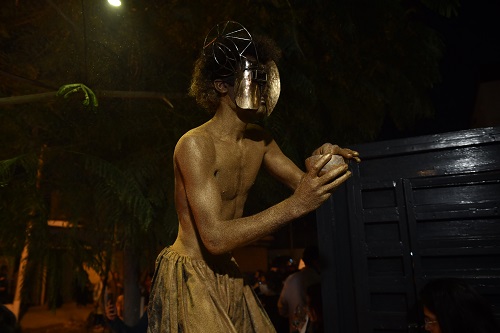
A kind of collective exposure occurs as Amin and his 17 collaborators pour out into the space where boundaries between bodies become permeable. But while he intentionally conducts an exposure of some, there is also a protective ambiguity of others that occurs in this piece, playing with social constructs around gender and sexuality, embodied in the objects that behave as both armor and invitation in these moments.
Particularly entrancing is the role of the inquisitor – a disruptive presence, confronting solely the men in the audience, played by Maha Minhaj, her face shrouded in copper mesh, who demands to know in Urdu: “Who are you?” “What are you doing here?” “Where did you come from?” The idea of confronting is essential here, because the exchange is meant to create discomfort not just internally but also physically in those questioned. This confrontation can be seen as a possibility of social expectations created in this space. Bodies shift nervously when the inquisitor nears, retreating to a corner, sometimes behind another person, movements we don’t see men engage in often in this country. The gaze of the voyeur is inverted ironically by someone whose face never reveals itself during the performance; it is simply through the certainty of a body that moves as though it belongs, and a voice unrelenting towards those who attempt to escape. We see these interactions between inquisitor and audience extend beyond the gallery, with gates open onto the road. The inquisitor moves through the audience to onlookers and once again the boundaries of who belongs in this space and who is an outsider are called into question by this movement.
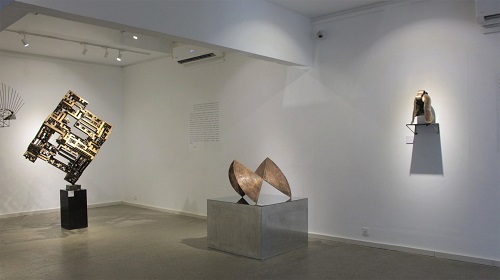 These purposeful details, the stretching of performance beyond the space that was meant to (or maybe falsely imagined to) contain it behaves as an expansion and once again an entanglement intrinsically central to Amin’s engagement with Quantum ideas, suggested by the title of the show, Spooky Action at a Distance, a term Albert Einstein used to dismissively describe quantum entanglement. According to Adam Fahy-Majeed, the curator of the exhibition, these ideas were vindicated, however, in the 2022 Nobel Prize for Physics, in which three scientists who have proven the existence of quantum entanglement were rewarded for their contributions to our understanding of that which underpins the most fundamental movements of the world around us.
These purposeful details, the stretching of performance beyond the space that was meant to (or maybe falsely imagined to) contain it behaves as an expansion and once again an entanglement intrinsically central to Amin’s engagement with Quantum ideas, suggested by the title of the show, Spooky Action at a Distance, a term Albert Einstein used to dismissively describe quantum entanglement. According to Adam Fahy-Majeed, the curator of the exhibition, these ideas were vindicated, however, in the 2022 Nobel Prize for Physics, in which three scientists who have proven the existence of quantum entanglement were rewarded for their contributions to our understanding of that which underpins the most fundamental movements of the world around us.
Through these acts of negotiation that take place throughout, there emerges a shared condition, one which only confirms the many forms of quantum entanglement that unfold in the work. This entanglement then is not a single moment but can perhaps be imagined as a movement. One’s eyes can fall upon a particular object or performer, but this movement is in fact speaking to another unfolding in a different part of the space. This is what lends to the necessity of the audience to move through the space themselves. All particles must be in motion. And perhaps this shared condition of movement within the space is in fact Amin’s own spirit that travels through the objects, those collaborating with him and those moved by him.
This collaborative performance, like many others that Amin Gulgee has conducted, utilises the somewhat confined space of the gallery. At first it feels suffocating to move through a sea of people hungry to be entranced, but this spatial limitation reveals itself to be an offering instead
 Materiality plays a dual role, as the sculptures themselves are constantly in an act of producing space, of curating expectations of what it is to follow. Each of the seven helmets taken off their stands and worn by a performer reads like an embodiment of a distinct spiritual facet. Through witnessing this process of becoming—the birth of these new roles that emerge as performer interacts with sculpture—the audience has an opportunity to become a part of the journey that Amin has imagined. Imbuing objects with changing meanings allows these inanimate participants to become collaborators as well, carrying a story through movement that perhaps they cannot express in stillness on a plinth or placed against a wall. Even the sculptures that remain in place, such as Perforated Scroll (2018) or Ascension (2018), stand almost as talismans, visual manifestations of a collective state unfolding in the present moment. There is a spirituality literally present in the materiality of Amin’s objects.
Materiality plays a dual role, as the sculptures themselves are constantly in an act of producing space, of curating expectations of what it is to follow. Each of the seven helmets taken off their stands and worn by a performer reads like an embodiment of a distinct spiritual facet. Through witnessing this process of becoming—the birth of these new roles that emerge as performer interacts with sculpture—the audience has an opportunity to become a part of the journey that Amin has imagined. Imbuing objects with changing meanings allows these inanimate participants to become collaborators as well, carrying a story through movement that perhaps they cannot express in stillness on a plinth or placed against a wall. Even the sculptures that remain in place, such as Perforated Scroll (2018) or Ascension (2018), stand almost as talismans, visual manifestations of a collective state unfolding in the present moment. There is a spirituality literally present in the materiality of Amin’s objects.
And there is an emotive quality central to the unraveling of the performance, fragments of which are dispersed amongst objects and people; a sense of grief and longing lingers in their movements. The ritual and repetition in these movements create a sense of familiarity that can almost be tasted amidst the sights, sounds, textures and scents. It is a feeling that persists even in absence, in moments when one can only access glimpses through a crowd, sensations traveling to you still. Perhaps it is this element of familiarity that lends the illusion of order, of a secret that the audience is being let into, a fleeting feeling that one might place the fragments together and it will all fit neatly into a narrative.
Particularly entrancing is the role of the inquisitor – a disruptive presence, confronting solely the men in the audience, played by Maha Minhaj, her face shrouded in copper mesh, who demands to know in Urdu: “Who are you?” “What are you doing here?” “Where did you come from?”
 Performance art is meant to expose the body of the artist, the materials, surfaces, spaces within which the artist is working, and Amin does this beautifully by extending this exposure to the audience as well. This collaborative performance, like many others that he has conducted, utilises the somewhat confined space of the gallery. At first it feels suffocating to move through a sea of people hungry to be entranced, but this spatial limitation reveals itself to be an offering instead. It is an almost necessary aspect of the unfolding of the experience, forcing the audience to be immersed, and in some sense to emerge as something slightly different, changed through their interactions, their participation or acts of retreat, carrying that forth outside the space even once it’s over. People leave knowing they are witnesses and storytellers of the moments they experienced in physical closeness. Perhaps it’s not necessary to see every detail. Perhaps it is enough to ‘know’ only a specific aspect of the whole performance.
Performance art is meant to expose the body of the artist, the materials, surfaces, spaces within which the artist is working, and Amin does this beautifully by extending this exposure to the audience as well. This collaborative performance, like many others that he has conducted, utilises the somewhat confined space of the gallery. At first it feels suffocating to move through a sea of people hungry to be entranced, but this spatial limitation reveals itself to be an offering instead. It is an almost necessary aspect of the unfolding of the experience, forcing the audience to be immersed, and in some sense to emerge as something slightly different, changed through their interactions, their participation or acts of retreat, carrying that forth outside the space even once it’s over. People leave knowing they are witnesses and storytellers of the moments they experienced in physical closeness. Perhaps it’s not necessary to see every detail. Perhaps it is enough to ‘know’ only a specific aspect of the whole performance.
A kind of collective exposure occurs as Amin and his 17 collaborators pour out into the space where boundaries between bodies become permeable. But while he intentionally conducts an exposure of some, there is also a protective ambiguity of others that occurs in this piece, playing with social constructs around gender and sexuality, embodied in the objects that behave as both armor and invitation in these moments.
Particularly entrancing is the role of the inquisitor – a disruptive presence, confronting solely the men in the audience, played by Maha Minhaj, her face shrouded in copper mesh, who demands to know in Urdu: “Who are you?” “What are you doing here?” “Where did you come from?” The idea of confronting is essential here, because the exchange is meant to create discomfort not just internally but also physically in those questioned. This confrontation can be seen as a possibility of social expectations created in this space. Bodies shift nervously when the inquisitor nears, retreating to a corner, sometimes behind another person, movements we don’t see men engage in often in this country. The gaze of the voyeur is inverted ironically by someone whose face never reveals itself during the performance; it is simply through the certainty of a body that moves as though it belongs, and a voice unrelenting towards those who attempt to escape. We see these interactions between inquisitor and audience extend beyond the gallery, with gates open onto the road. The inquisitor moves through the audience to onlookers and once again the boundaries of who belongs in this space and who is an outsider are called into question by this movement.
 These purposeful details, the stretching of performance beyond the space that was meant to (or maybe falsely imagined to) contain it behaves as an expansion and once again an entanglement intrinsically central to Amin’s engagement with Quantum ideas, suggested by the title of the show, Spooky Action at a Distance, a term Albert Einstein used to dismissively describe quantum entanglement. According to Adam Fahy-Majeed, the curator of the exhibition, these ideas were vindicated, however, in the 2022 Nobel Prize for Physics, in which three scientists who have proven the existence of quantum entanglement were rewarded for their contributions to our understanding of that which underpins the most fundamental movements of the world around us.
These purposeful details, the stretching of performance beyond the space that was meant to (or maybe falsely imagined to) contain it behaves as an expansion and once again an entanglement intrinsically central to Amin’s engagement with Quantum ideas, suggested by the title of the show, Spooky Action at a Distance, a term Albert Einstein used to dismissively describe quantum entanglement. According to Adam Fahy-Majeed, the curator of the exhibition, these ideas were vindicated, however, in the 2022 Nobel Prize for Physics, in which three scientists who have proven the existence of quantum entanglement were rewarded for their contributions to our understanding of that which underpins the most fundamental movements of the world around us.Through these acts of negotiation that take place throughout, there emerges a shared condition, one which only confirms the many forms of quantum entanglement that unfold in the work. This entanglement then is not a single moment but can perhaps be imagined as a movement. One’s eyes can fall upon a particular object or performer, but this movement is in fact speaking to another unfolding in a different part of the space. This is what lends to the necessity of the audience to move through the space themselves. All particles must be in motion. And perhaps this shared condition of movement within the space is in fact Amin’s own spirit that travels through the objects, those collaborating with him and those moved by him.

